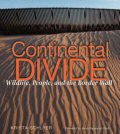SEJournal Online is the digital news magazine of the Society of Environmental Journalists. Learn more about SEJournal Online, including submission, subscription and advertising information.

Book Shelf
Continental Divide: Wildlife, People, and the Border Wall
By Krista Schlyer
Texas A & M University Press, $30
Reviewed by TOM HENRY
Krista Schlyer’s book, “Continental Divide: Wildlife, People, and the Border Wall” is far more than a book chock full of great photographs — and, trust me, they are great, whether Schlyer is showing the playfulness of prairie dogs, the rugged beauty of bison, or the poignancy of a makeshift memorial for a woman who symbolizes the struggle of border crossings.
What I didn’t expect, frankly, was such a beautiful job of storytelling. This book is a highly satisfying package of text and images, a complete work of great journalism that penetrates the reader’s psyche with compassion. It is educational and inspirational.
I’ve spent much of my life living near an international border and, like many people in the Great Lakes region, haven’t stood back and thought about it much. Former President Harry Truman described the U.S.-Canada border as the world’s friendliest in 1947 and, more than 65 years later, Truman’s observation remains valid.
Through Schlyer’s book, I found myself much more empathetic about issues that affect the U.S.-Mexico border and about border issues in general, including parallel ones affecting humans and wildlife here in the Great Lakes region. Schlyer’s book makes the case for why the U.S.-Mexico border wall is not only bad and ineffective policy, but destructive to a shared ecology and to the soulful fabric that has united the Southwest for generations.
“Wherever there are borders — whether they exist between nations or between rich and poor, old and young, or black, white, and brown — it is easy to amplify fears to the point that they distort reality,” she writes. “Borderlands, whether in the mind or on the map, are always vulnerable to misperception, so much so that at times reality becomes unrecognizable.”
This book dazzles you with photographs and with the research Schlyer put into explaining the science and politics of U.S.-Mexico border issues.
But it also gives you a sense of life along the border as seen through the eyes of some die-hard souls who live there. Schlyer did an exemplary job of finding real characters willing to share their stories, as well as the broader big-picture stuff. Her book shows a real commitment to the U.S.-Mexico border. It gets readers to understand why they should care.
Tom Henry writes for The (Toledo) Blade. He is a member of SEJ’s board of directors, SEJournal’s editorial board and is SEJournal’s book editor.
* From the quarterly newsletter SEJournal, Spring 2013. Each new issue of SEJournal is available to members and subscribers only; find subscription information here or learn how to join SEJ. Past issues are archived for the public here.













 Advertisement
Advertisement 



